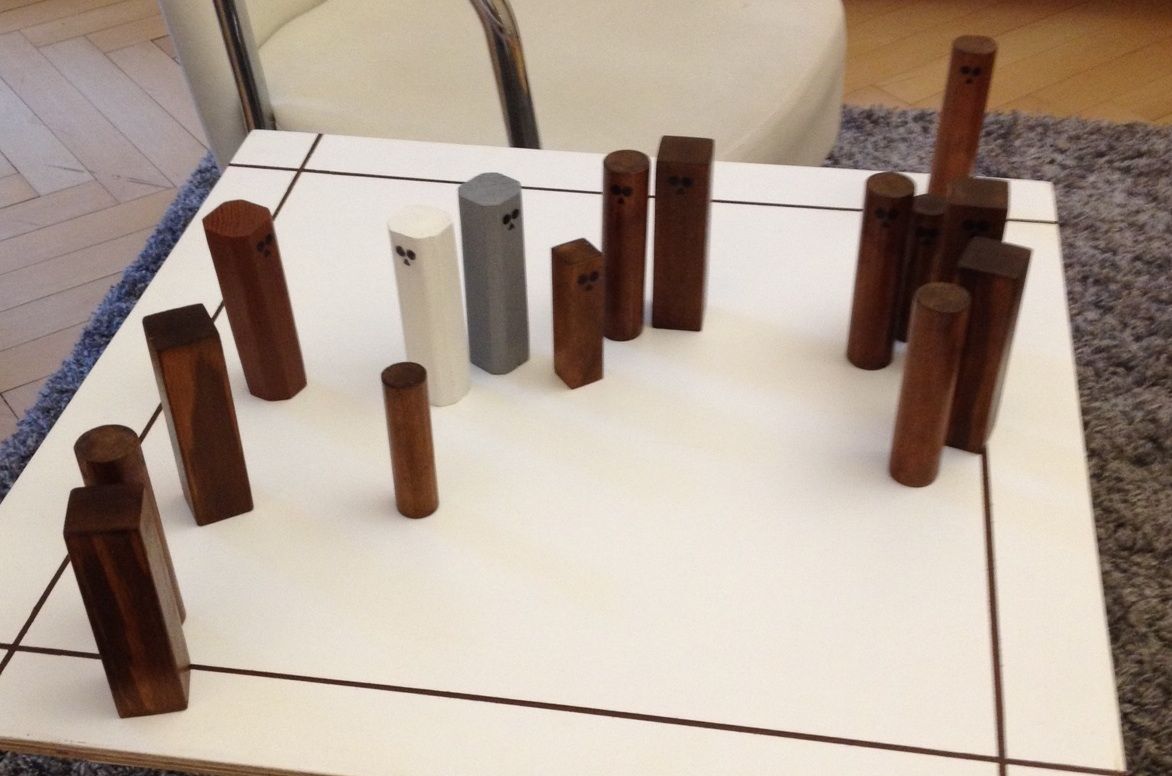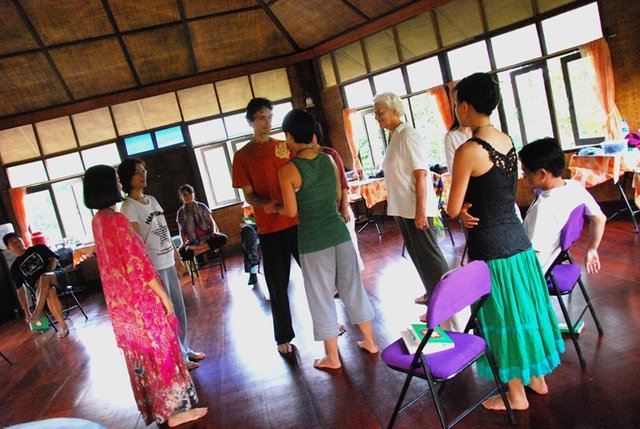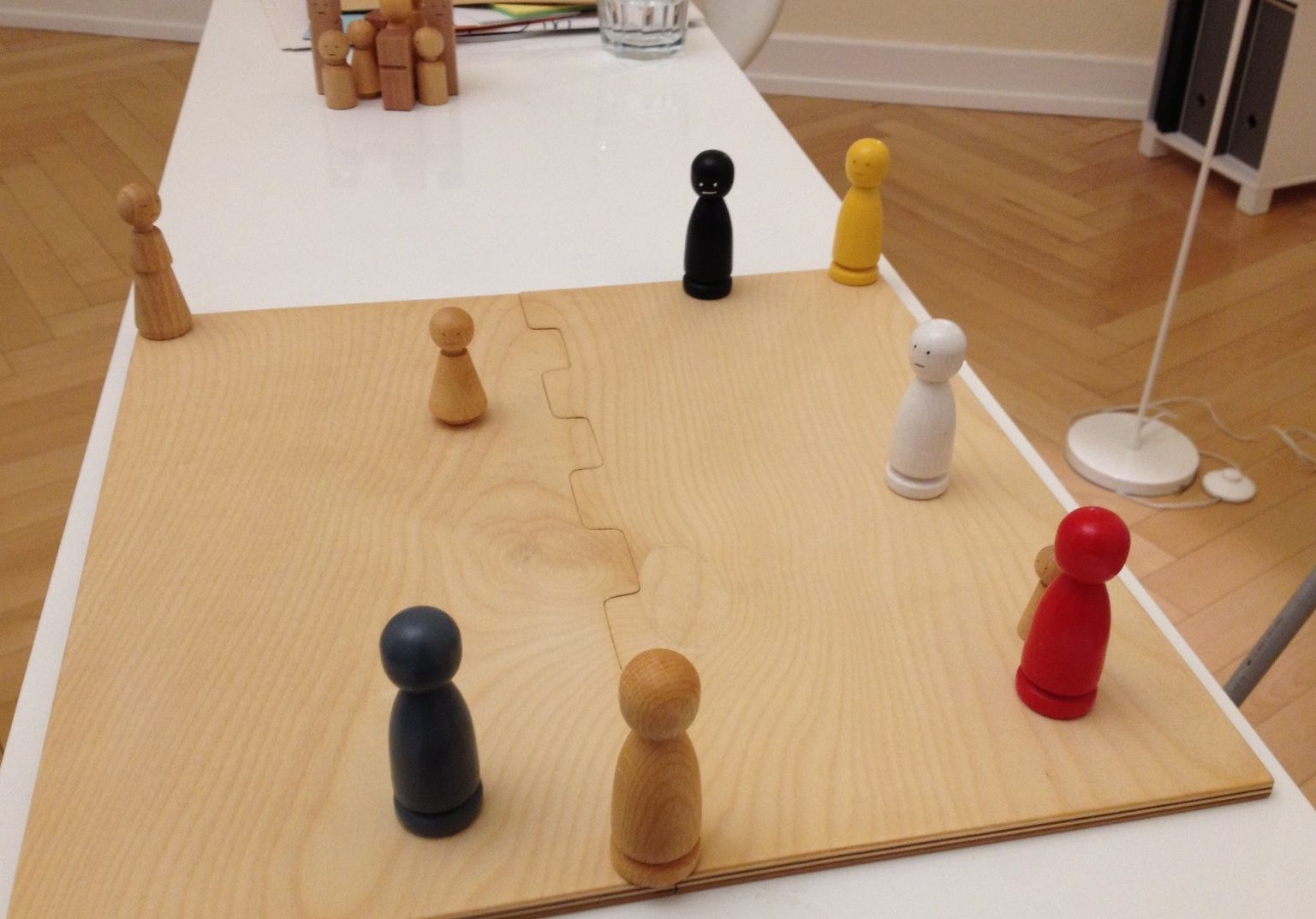Family problems? A constellation could help. How to get a playful perspective with dolls and a wooden board.
Dear reader,
Have you ever made a drawing of your relationships? In particular those with your family and got an instant insight about it? No? Or do you find it unusual to approach the core of a thing by means of the method of drawing or arranging?
Than I would like you to offer the systemic integrative method of a "family board".
But let me first depict it.
If I were to ask you which symbol (object, animal, color, smell, etc.) you would give for a person who is extremely unpleasant to you: what symbol would that be?
I would think of a barking dog, for example, when I think of a person who is not well disposed towards me or who has been criticizing me sharply. Or a cardinal's robe for a person who can see right through me. Or a rock/stone for a person who seems impenetrable.
Using the family board is a constructivist approach - according to family constellations work which differs from the phenomenological approach in that it is not real people who are set up, but figures or rather they symbolize people or specific problems.
Here is an example:
This family board was put up in a session I led. I won't make an interpretation in order to protect my clients privacy.
The phenomenological approach became famous in Germany mainly because of the constellation work according to Bert Hellinger - who is discussed very controversial. I call him because of completeness and his fame. As far as I know, he was the first to make this method widely "popular". In my education he didn't play a role. The advantage of the constructivist method is that it comes about with less effort and not all people are convinced of the phenomenon of the representative family member. On the other hand, it is easier for us to give a symbol or a certain color or shape to a matter in our life. However, both methods are successfully applied and, depending on what people prefer, are involved in systemic work with clients.
For many people, the constellation work is a hocus-pocus and I have to say that I also had some difficulties with it in my training. Nevertheless, I found the practical work quite remarkable and would have liked to continue practicing it. However, as I have said, it is rather cumbersome to get so many substitutes together for a family system, so that I have so far only remained with the constructivist method.As there is no real good wiki publishing in English, I translate and quote from the German version:
Origin and similar procedures
In the psychodrama, the Austrian doctor Jakob Moreno chose a representative for the persons concerned in a conflict to be dealt with. The representatives had to dramaturgically portray that conflict in their roles (as opposed to family jobs).
The "Family Sculpture", developed by Virginia Satir (Palo Alto Group): This method already used spatial arrangements among the (partly real present) family members, whereby the main focus was/is initially on the current relationship system of the respective client's family, and secondly not so much on the spatial arrangement alone, but rather on the physical sculptures or postures that were/are reproduced (from linguistically metaphorical references of the client in relationship problem descriptions).
Thus, the created family sculpture (external illustration) enables the respective client to depict family relationships in a non-verbal way and to reconstruct (interior, sometimes linguistically represented) conflicts (from the picture of family sculpture). On this (symptomatic) basis the process work (often reframing) was done by Virginia Satir. During the "Family Reconstruction" Virginia Satir added the multi-generational perspective.
Applications from hypnotherapy according to Milton H. Erickson were characteristic for the semantics within the family constellation.
Equilibrium and order:
Iván Böszörményi-Nagy, Geraldine M. Spark (Invisible bonds. The dynamics of family systems), USA 1965 (English 1973); see also Parentification.
Bert Hellinger is responsible for the additional affiliation (binding) to the respective system.
I mentioned V. Satir and her group in a former article of mine.
What is the benefit of using a family board? You can look at the board from different perspectives. Mainly, one gets the possibility to position the persons involved in such a way as it is perceived from one's own point of view. At the same time, an external perspective is taken and it is possible to try out new positions and let them have an effect on you. You can set an "actual" constellation and then a "target"(required) constellation. The latter can serve as a goal. Figures vary in For working with a 'classic family board' the following are also suitable While working with the board and a client the most interesting question after the board is done is: People tend not to place such persons (persona non grata) whom they do not want in their lives. But it is precisely those who are the ones who should definitely be set up or, if this is too painful, those who are to be mentioned, because it must be clear that an important person is missing. You can either leave them there or take them off the board again. But now, knowing that this was done (!). In my penultimate article I mentioned the subject of excluding unpleasant people and why it is better to choose an integrative form of confrontation. If only as a substitute. The visibility of loved or unloved people makes the family board in my eyes so successful -among other things - in its application. You can otherwise waste a lot of words and as an consultant you can spend a painful lot of time to find out where the family is stuck. I tried, believe me. and were you able to tell immediately where the shoe pinched? It's hard for me anyway, so working with things is much easier. And if I were asked to place my family by means of figures, I would think less about words and just start at first. It should be noted that the method is not suitable for everyone. A systemic consultant must test and evaluate this. There are people who have no connection to act in a playful way. But you would be surprised how many indeed have! I don't give you an interpretation on this either but rather I ask you, what do you see? From what I experienced within myself and others by using the board is, that if there were difficulties in placing the figures, this already was a sign for something. When you have troubles in deciding where your spouse is supposed to be, then it can, but does not necessarily have to be an indication that the person in the job is either not sure where his partner actually stands (emotionally) or speculates on the basis of this person or isn't sure him- or herself. As I have been able to observe, it can be particularly surprising for those involved witnesses (e. g. couples) to see how the other person places his system. One client said something like "I'm shocked that you're putting the system in this way! I never would have thought so!" I was able to observe how astonishment was accompanied by compassion and how understanding of each other's situation immediately set in. Making a situation visible is fundamentally different from conveying it verbally. While verbal communication is often accompanied by the desire to be right, as well as problems of definition and misunderstandings, visual communication conveys a result much more quickly, i. e. the perceived situation of a person. It is about reducing complexity. The infinitely varied interplay in a family is brought to a point and can be viewed from there. The family board as a visual aid can help all those involved to observe and think through the situation in peace and quiet, and possibly even illustrated triggers for feelings can be identified and experienced. This is also because this is a not yet accustomed form of communication in the consulting process of people, i. e. it interrupts the familiar. Circular questions (which I have already explained in an article of mine) can help to increase the collection of information and create even more transparency and plasticity. The family board makes social connections, in the family, visible to everyone, as well as relationship structures and functionalities. Was it the first time for you to hear of a family board? Please tell me, I would like to know. text sources:
https://en.wikipedia.org/wiki/Family_Constellations) picture sources: family board 1 and 2: my own pictures SteemSTEM is a community driven project which seeks to promote well written/informative Science Technology Engineering and Mathematics postings on Steemit. The project not only curates STEM posts on the platform through both voting and resteeming, but also re-distributes curation rewards as STEEM Power, to members of Steemit's growing scientific/tech community.VISIBILITY - Talk, talk, talk or see clearly from above?
Distance, angle and line of sight are understood to be primarily relevant among the persons who represent.
The advantages and quickly answered aspects are:
"Who does not stand on the board?"
Sometimes clients can't even narrow it down so well themselves, because much of what is conflict-rich doesn't get to the heart of the matter right away.Have you ever gone to a counseling interview right after work
Here is another constellation:
What impression does this constellation make on you?
Do you have any particular thoughts and feelings?
Count in how many figures you see, how they stand to each other, their distance and towards their faces direct.Possible impacts on witnesses
Information generated in this way may even be pronounced for the first time.
Thank you for reading!
https://en.wikipedia.org/wiki/Bert_Hellinger
http://www.systemagazin.de/bibliothek/texte/Ludewig_Systemische_Therapie.pdf (only German)
https://de.wikipedia.org/wiki/Familienaufstellung (German/translated quote)
http://www.v-r.de/pdf/titel_inhalt_und_leseprobe/116745/inhaltundleseprobe_978-3-525-45659-0.pdf (German)
http://www.systemagazin.de/bibliothek/texte/Ludewig_Systemische_Therapie.pdf (German)
family constellation phenomenological: Arden Wong [CC BY-SA 3.0 (https://creativecommons.org/licenses/by-sa/3.0)], via Wikimedia Commons




Системно-семейная психология сложное направление, расстановки по Хеллингеру очень интересная штука. Можно на фигурках делать, можно вживую.
I would have preferred you leaving a comment in English. In upvoting your own comment you took my chance to place the comments in the order I would like them to be here on my blog. If I searched correctly you even did not leave an upvote on my article so I assume you just abused it randomly.
Well, I actually think, that in one or other way this is giving you bad karma - I hope, you'll get some lovin. Try out to be generous to other people, it really is a nice experience and you will gain more of it, believe me:)
Good post
This is the first time I've heard of the family board as a psychology tool, but it works so intuitively that it was easy to understand how it works. Thanks for sharing. Definitely a cool fact.
Thank you for answering & reading my article & liking it.
I was asking in the chat if this is of interested and got a "go". For me this is self-evident but I underestimated that it is not for others.
Yes, intuition is a good term for that also. I had once a client who thought too much and it was a bit difficult. But mostly people act spontaneously. Once a client agrees in experimenting and trying out a method, the work flows nicely.
Another great article, dear! My respect to your work. <3
Thank you @laylahsophia! Always appreciated when you swing by.
@erh.germany,
Your post brought up some fond memories of my late father.
He was a shrink...
Namaste, my friend.
JaiChai
P.S.
Calling on the @originalworks upvote to add to my own now.
oops, this voting slider confuses me still. Hope my other commenters don't mind... As I try to place them in order how they came in...
THANK you for coming by, @jaichai - your dad was a shrink? Oh, well that can sometimes be a bit difficult. teachers and shrinks are known to be special parents. LOL.
Please correct me, if I am wrong and then I'll take everything back.
My son one day told me: "Mom, you are like my class teacher!" And that was not a compliment :-)
The @OriginalWorks bot has determined this post by @erh.germany to be original material and upvoted it!
To call @OriginalWorks, simply reply to any post with @originalworks or !originalworks in your message!
I’m not going to pretend to understand all of this however it looks like a potentially very effective way to provide counselling to someone. Is it normally used on children or do you use this strategy with adults as well?
Thanks.
Yes, I consider it effective and it depends if the client does that, too. Then working with this method is really helpful. So far I haven't worked with the board with children, only with adults. I guess with children it would be even more effective because they do not think that much and act more spontaneously.
That's really interesting. Do you work mostly with adults then?
yes, I work mostly with adults (singles and couples) and also with young adults from 16 up to 21. Is there anything in particular you want to know (about children)?
No, just curious about your work. It's such a fascinating field. :)
I have heard of "Familienaufstellung", which this seems to be, right? Didn't know, one could also use a board.
Which brings me to answering your question: To the right, I see a group of people, occupying a territory and the white "guy" in the middle tells the ones to the left, they better not cross that (crooked) line. The figure closest to the viewer must be a teenager, as he/she is challenging that..
I'm serious (stone face)
(giggle)
no really, I am! 😇
correct!
Yes, the board is a different approach for the same thing. To reveal and make the constellation visible.
You have a good eye, the white "guy" is indeed the main person and the others are family members. The crooked line has no meaning actually because my board is transportable and you can fold it in two halves. Little figures usually are taken for children, that's right. Remember that all figures in place show the currently felt connection to one another and represent the view of the constructer. So the distances between the substitutes are not only the will of the person doing the constellation but also how she/he perceives where they stand.
Funny, you:-)
first time to read about family board. i know about family constellations, it is on my to do list for some years, but things never connected for me to experience it.
as i saw the board, there were a group of nice figures somewhere far away and in front there were lots of figures, some more close to the others or not. i saw them far away from each other, but somehow still connected, no matter in which corner they were hiding.
very interesting method! is it part of the family constellations? is it 1 on 1 therapy or a group kind of?
thanks for commenting!
Just try it out & write a post about it:) - I found it interesting to do that with real people and it may give you some insights.
Smile. The figures in the back of the picture actually do not belong to the making off the constellation. They were just placed there because not all of them got used in that session:)
The figures placed in the corner and standing far away from each other told of a connection, that's right.
Yes, it is part of family constellation, only constructed with symbolic figures. It is one on one, not with a group. When I would ask you to choose figures and to place yourself and the members of your family on the board the result is going to show - among other things - how you feel connected or disconnected to them.
You could also use a paper sheet and draw it but then it is only 2dimensional.
Compare it to describe your family situation in words. Feel the difference.
These tools seem to me to be considerably good, since it gives us the opportunity to draw considerably on therapeutic material, I have training in psychodrama but not in family constellations, so enjoy your illustration
thank you, totally so!
I use all kinds of material and bring a bag with stuff to my sessions whenever I have the chance in doing so. In there are stones of different sizes, seashells, postcards with motives, origami figures etc. - also one can use a long elastic band for couples. You let them take it, step into it and then stretch it to the extend they think it suits for them. How they stand in the band is showing if the band is stretched to the very extend or hangs down lose - it is interesting how often the couple might want to change their stand and how long it also takes until the set is done. I really like to use those helpers.
Maybe you know some of these methods?
Psychodrama I have no experience in.
Davon habe ich auch schon viel Gutes gehört. Selber habe ich es allerdings noch nicht ausprobiert, bin aber neugierig 😉 Sehr interessantes Thema! Danke für den ausführlichen Post.
Gern geschehen!
Die systemische Beratung ist hier in Deutschland ja eher ein Stiefkind. Und im Ausland wie es ausschaut, noch weniger bekannt. Ich vergesse manchmal, wie lange es braucht, bis sich eine bestimmte Richtung als Gemeinwissen etabliert hat.
Ausprobieren kannst du es wahrscheinlich nur im Rahmen einer Therapie (von einem systemisch arbeitenden Therapeuten) oder einer privaten Beratung. Solltest du das machen, sag Bescheid, wie es war ;-)
Viele Grüße aus Hamburg nach ... ?
Hannover ;)